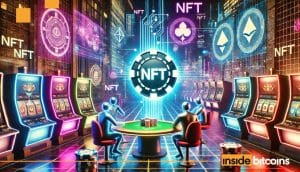Once celebrated as a revolutionary force, NFTs have seen a dramatic shift in fortunes over the past few years. In 2021, the NFT market boasted a staggering $17.6 billion in value. However, by 2024, trading volumes had dropped by 19%, and overall sales shrank from 60.6 million to just 49.8 million. Even the iconic Bored Ape Yacht Club and CryptoPunks collections are finding it increasingly difficult to stay relevant, with over 98% of new NFT projects in 2024 failing to maintain value or capture significant audience interest.
A high-profile example of this downturn is DraftKings’ decision to shut down its NFT platform, Reignmakers, which cited mounting legal challenges and dwindling user engagement. Yet, despite these setbacks in the speculative arena, a more promising horizon emerges within iGaming. Here, NFTs could be repurposed as powerful tools that redefine player engagement and ownership.
From Speculation to Utility
The fundamental appeal of NFTs lies in their ability to confer verifiable ownership—a concept that goes far beyond digital art. In the realm of iGaming, NFTs have the potential to evolve into functional assets that enhance gameplay through personalization and cross-platform integration. Imagine owning an NFT that serves as a personalized avatar at a virtual poker table or as a dynamic jackpot symbol that links experiences across multiple games and operators. These are not merely imaginative scenarios; they represent tangible opportunities for deeper player engagement.
Platforms like Aviatrix.bet are already exploring this potential by integrating NFTs into multiplayer games. By allowing players to customize their gaming experience and trade in-game assets, these initiatives are laying the groundwork for a new era in iGaming—one where digital ownership translates into real-world utility.
Learning from Early Missteps
Not every attempt to integrate NFTs into iGaming has succeeded. For instance, Red Tiger’s NFT-integrated slot game, NFTMegaways, incorporated NFTs into its design without providing players with the ability to interact with or own them directly. For NFTs to thrive in this space, they must move beyond ornamental roles to offer genuine functionality—enhancing gameplay, generating new revenue streams for operators, and empowering players with assets that have real utility across diverse platforms.
Navigating Legal and Regulatory Challenges
The journey ahead is not without its hurdles. Legal uncertainty remains a significant challenge, as evidenced by DraftKings’ abrupt exit from the NFT space. With regulatory bodies increasingly scrutinizing NFTs—often categorizing them under securities laws—operators are rightfully cautious about investing in NFT-driven solutions in the absence of clear legal guidelines. However, with robust regulatory frameworks in place, NFTs could underpin innovations such as provably fair gaming systems, blockchain-based loyalty programs, and cross-platform interoperability protocols.
How about AI?
Can Artificial Intelligence (AI), which has been all the hype lately, revive NFTs? For one, AI has the potential to enhance the creation, personalization, security, and valuation of such digital assets. And by integrating AI, the NFT ecosystem can offer more dynamic and engaging experiences to both creators and collectors.
In the realm of creation, AI algorithms can generate unique and complex digital artworks, expanding the creative possibilities for artists. For instance, the AI algorithm Botto produces 350 pieces of art each week, with its notable creation “Asymmetrical Liberation” selling for 79 ETH in October 2021. Similarly, platforms like Artbreeder utilize machine learning to create visually captivating art, which artists can then tokenize and sell in NFT marketplaces.
AI also enhances the personalization of NFT marketplaces by analyzing user preferences and behaviors to recommend digital assets that align with individual tastes. This personalized approach improves the discovery process, making it easier for collectors to find art that resonates with them, thereby increasing user engagement and satisfaction.
Moreover, AI contributes to the security and authenticity of NFTs by assisting in fraud detection. By analyzing transaction patterns and metadata, AI systems can identify counterfeit NFTs and verify the legitimacy of digital assets, maintaining trust within the marketplace. Additionally, AI can aid in the valuation of NFTs by analyzing market trends and pricing data, providing insights that help buyers and sellers make informed decisions. This data-driven approach can lead to more strategic investments in the NFT space.
So AI, which is here to stay, can greatly help the NFT space and bring innovations that could reverse its decline.
A New Chapter for NFTs in iGaming
The decline of NFTs as speculative assets signals not the end of their story, but rather a pivot toward a more sustainable, utility-driven future. For iGaming, this shift represents an opportunity to reimagine digital assets as functional tools that enhance player experiences. The focus must now be on delivering real value—ensuring that NFTs are indispensable components of innovative gaming ecosystems rather than just digital novelties.
We see the end of the NFT hype as a wake-up call for smarter, more meaningful innovation. As the industry moves beyond speculative bubbles and toward functionality, those who embrace creative, utility-focused approaches will be best positioned to shape the future of iGaming.
The hype may be over, but the possibilities are just getting started.
Related News
Lucky Block Casino - Decentralized Gambling Platform

- Bet With Crypto - BTC, ETH, USDT, LBLOCK and More
- Live Dealers - luckyblock.com
- Rated Best New Crypto Casino - No KYC
- Thousands of Slots, Blackjack, Roulette Games



